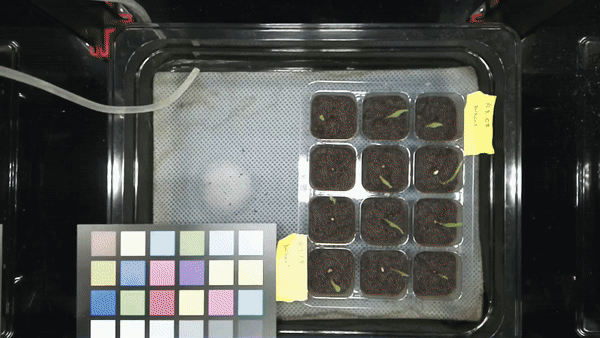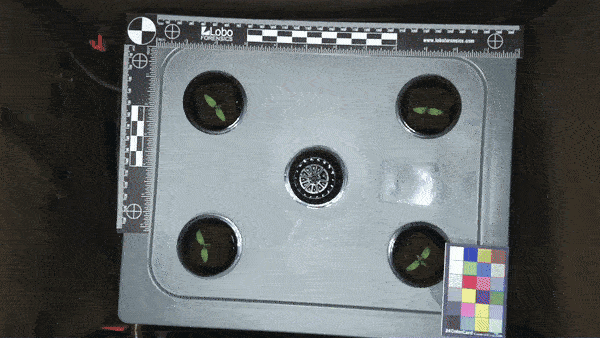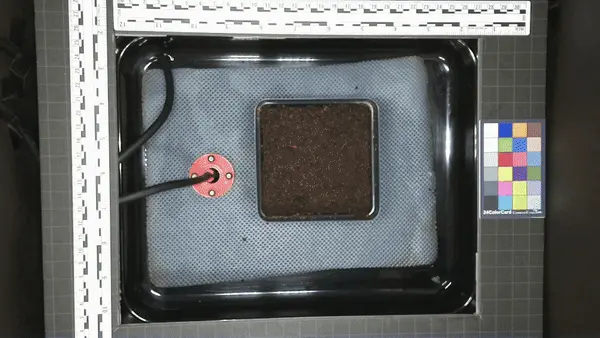Here’s the original publication by Dr. Bugbee for the USU Apogee wheat.
Are you able to share these results? It would be interesting to compare them with those shared in the publication!
Also @Surendra, are you able to share a link to the recipes you used to grow the wheat? I see that you have created quite a few custom recipes and would be interested to hear how you (as a plant scientist) approach determining the settings to use when creating a recipe. Did you try to recreate the conditions used in Dr. Bugbee’s procedure? Alternatively, if you didn’t use the recommendations from the publication (as a non-academic that’s what I’d assume I should do) I’d be interested to hear why.
Also, did you see this hilarious/fascinating note in that paper from 1999 about the impact of mice in breeding operations long-term?
Mice got into the greenhouse prior to harvest in the F8 generation and attacked all six replicate plots of USU-Apogee. No other plots were damaged. Selective seed consumption by mice among field breeding lines has occurred previously at Utah State University, and may be caused by subtle differences in volatile compounds among lines.
Agriculture is awesome.
I took a few minutes to poke around about recommended settings for the USU-Apogee wheat and am super excited about this cultivar! What a great find - kudos to you @Surendra! Would you mind sharing a bit more about how you were able to source the seeds so that others could potentially access them as well?
I’d like to also share some of the research I found with ChatGPT about USU-Apogee that’s been done since 1999 - lots of cool stuff to dig into further.
Below is a list of the conditions I found mentioned in the original 1999 paper about USU-Apogee published by Utah State University:
- CO₂ Concentration: The CO₂ levels were raised significantly, but specific CO₂ concentrations ranged between 350 to 1000 ppm during various tests. The CO₂ enrichment was essential to support high growth rates under controlled environments(DigitalCommons@USU).
- Greenhouse Location & Season: The study was conducted in a temperature-controlled greenhouse located at Utah State University. There is no specific mention of the external season, as the greenhouse conditions were tightly regulated throughout the year(DigitalCommons@USUDigitalCommons@USU).
- Daily Light Integral (DLI): The light conditions included continuous 24-hour lighting provided by high-pressure sodium lamps with a light intensity of 350 µmol m⁻² s⁻¹. Based on this, the expected DLI would be approximately 30.2 mol m⁻² day⁻¹(DigitalCommons@USU).
- Thermoperiod: The temperature was held constant at 25°C for most of the experiments, with no mention of varying day/night temperatures, implying that there was no thermoperiod applied during growth(DigitalCommons@USU).
- Nutrient Solution: A hydroponic nutrient solution was used, optimized for high CO₂ and enclosed environments. The specific solution was based on Utah Hydroponic Solutions, which has been refined over time using tissue analysis to provide optimal concentrations of essential nutrients for growth(DigitalCommons@USU).
- Media: The plants were grown in a soilless hydroponic medium, which was continuously aerated and watered twice daily with the nutrient solution. This setup allowed for continuous cultivation and multiple yearly harvest cycles(DigitalCommons@USU,DigitalCommons@USU).
- Planting Density: The wheat was planted at a high density, with selections made to reduce tillering and interplant competition. This high-density planting allowed for optimizing space in the controlled environment(DigitalCommons@USU).
Below is a side-by-side comparison to newer papers:
| Factor | Original Study (USU-Apogee Wheat Registration) | Other Studies Using USU-Apogee |
|---|---|---|
| CO₂ Concentration | Elevated CO₂ levels, typically ranging between 350 and 1000 ppm, to enhance photosynthesis and growth in controlled environments (Bugbee et al., 1999). | Some studies also used elevated CO₂ (e.g., Klassen & Bugbee used levels up to 1200 ppm) for growth comparisons in greenhouse conditions (Klassen & Bugbee, 2002). |
| Light Intensity and Photoperiod | Continuous 24-hour light using high-pressure sodium lamps, with a light intensity of 350 µmol m⁻² s⁻¹ (Bugbee et al., 1999). | Continuous light (24-hour) was similarly used in many studies, such as in rapid cycling and transgenic research studies (Mackintosh et al., 2006). |
| Temperature | Constant temperature of 25°C, optimized for rapid growth (Bugbee et al., 1999). | Most studies involving ‘USU-Apogee’ used a similar constant temperature of 25°C. For example, the genetic basis study used constant warm temperature and long-day conditions for flowering analysis (Li et al., 2017). |
| Nutrient Solution | A hydroponic, soilless medium was used, watered twice daily with nutrient solution (Bugbee et al., 1999). | Hydroponic nutrient solutions were used in other studies, but specific formulations were sometimes modified. For instance, in proteomics studies, the nutrient concentration was adjusted depending on environmental factors (Vu et al., 2017). |
| Planting Density | High-density planting was emphasized to minimize tillering and interplant competition (Bugbee et al., 1999). | Varied densities were used depending on the study’s focus. For example, the transgenic research studies were more focused on individual plant response and less on high-density planting (Mackintosh et al., 2006). |
| Growth Media | Soilless, hydroponic medium, continuously aerated (Bugbee et al., 1999). | Studies varied in their use of media. Most followed hydroponic systems for consistency, but some used growth chambers with modified atmospheric conditions for specific research on stress responses, such as ethylene sensitivity (Klassen & Bugbee, 2002). |
Hello, my name is Dasha.
We grew Apogee Wheat over the summer, a dwarf variety of wheat. The GIF showcases the growth of the crop over the last 70 days in a MarsFarm growth chamber.


76 day trial of red robin tomatoes.
Education MARSfarm V1 Do-It-Yourself Plant Science Experiments
Hello, Attached is a GIF of the cherry bell radish I’ve been growing in the MV unit over the usmmer. This shows around 10 days of growth in the unit. Education Plant Science MARSfarm V1 Hardware
![ezgif-3-92f4f9a830.mp4 [optiwebp output image]](https://community.marsfarm.com/uploads/db6023/original/1X/15374fe180eeb036b6f6ddf089ecf0c8d12c70be.webp)
This is a crop that my peer, Sana Ahmed, grew in an MV unit over the summer. This gif is displaying 57 days of growth. It goes from very healthy stages growing large radishes to the leaves eventually wilting and the size of these radishes shrinking. This was partly due to the lack of replacing the nutrient solution in the tank.

Hello, I have attached a GIF displaying the growth of Salanova Red Lettuce in the MV during the first five days after transplantation. The lettuce goes from a strong purple color to now a vibrant green color. This is likely due to the change in the lighting spectrum and intensity.

I might recommend trying more nutrients next time - these looked a little light in the nitrogen. Great timelapse though - very cool!
@sana @xandrei @Jaiden @Dasha Thanks to all of you for sharing these awesome timelapses! Would one of you mind sharing the details about how you created these timelapses? I think it would be very cool for other people to learn about so they can repeat it themselves.
Did you just download the photos from the MV1 web app? Did you do one for every day - or what sampling rate?
FYI: I shared some examples of timelapses I think are cool in this post: